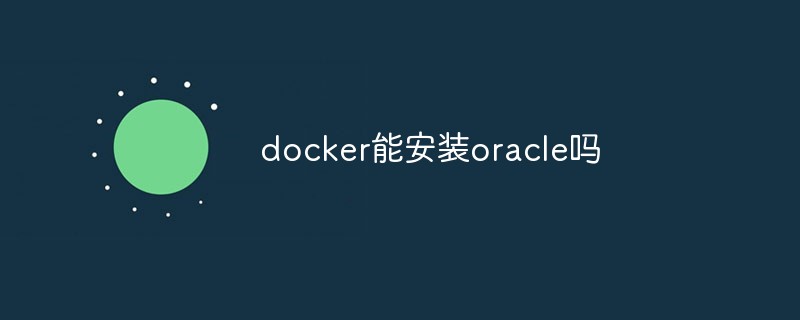 Java
Java javaTutorial
javaTutorial Use Docker to containerize Spring Boot applications to achieve continuous integration and continuous deployment
Use Docker to containerize Spring Boot applications to achieve continuous integration and continuous deployment
Use Docker to containerize Spring Boot applications to achieve continuous integration and continuous deployment
Docker is an open source containerization platform that can integrate applications and their dependent resources Packaged into a separate container and deployed and run through an image. It provides a lightweight, fast, and portable solution for building and deploying modern applications.
Spring Boot is a rapid development framework that provides a simple and scalable way to build Java applications. Combining Docker and Spring Boot, we can achieve the goal of quickly deploying, scaling and managing applications.
This article will introduce how to use Docker to containerize Spring Boot applications to implement continuous integration and continuous deployment processes, and provide corresponding code examples.
- Preparation
Before you start, make sure you have installed Docker and Java development environment, and have basic Spring Boot application development experience. - Creating a Spring Boot application
First, we need to create a simple Spring Boot application. You can use Spring Initializr (https://start.spring.io/) to quickly create a new Spring Boot project, or use an existing Spring Boot project.
Here, we create a simple Hello World application as shown below:
@Controller
public class HelloWorldController {
@GetMapping("/")
public String hello(Model model) {
model.addAttribute("message", "Hello, Docker!");
return "hello";
}
public static void main(String[] args) {
SpringApplication.run(HelloWorldController.class, args);
}
}This code creates a basic Spring MVC controller that when accessing the root path , returns a "Hello, Docker!" message.
- Building Docker Image
Next, we need to build an image that can be deployed by Docker. To do this, we need to create a Dockerfile to define the build rules for the image.
Create a file named Dockerfile in the root directory of the project and add the following content:
# 使用一个基础的Java 8镜像 FROM openjdk:8-jdk-alpine # 将应用的jar包添加到容器中 COPY target/demo-0.0.1-SNAPSHOT.jar /app.jar # 暴露8080端口 EXPOSE 8080 # 运行jar包 ENTRYPOINT ["java","-jar","/app.jar"]
The above Dockerfile uses the Java 8 image based on Alpine Linux as the base image. Then, copy the built jar package into the container and run the application through the ENTRYPOINT instruction.
The command to build the image is as follows:
$ docker build -t spring-boot-demo .
After the image is built, you can use the following command to verify whether the build is successful:
$ docker images
You should be able to see a name It is the mirror of spring-boot-demo.
- Running Docker Container
After we have the image, we can create and run the Docker container based on the image.
Run the following command to start the container:
$ docker run -d -p 8080:8080 spring-boot-demo
Among them, the -d parameter means running the container in the background, and the -p parameter means mapping the 8080 port of the host to the 8080 port of the container. .
To verify whether the container is started successfully, you can check the running status of the container through the following command:
$ docker ps
If you can see that the container named spring-boot-demo is running, it means the container is started successfully.
- Deploy updates
When the application has new updates, we can complete the application update and deployment through the following steps.
First, update the application code locally and rebuild the image:
$ docker build -t spring-boot-demo .
Then, stop and delete the old container:
$ docker stop [CONTAINER_ID] $ docker rm [CONTAINER_ID]
After that, Run the new container again:
$ docker run -d -p 8080:8080 spring-boot-demo
- Continuous Integration and Continuous Deployment
The above steps can be done manually to build and deploy the application, but for large-scale and frequent updates, this is obviously Inefficient and error-prone. Therefore, we can use CI/CD tools (such as Jenkins, GitLab CI, etc.) to achieve automated continuous integration and continuous deployment.
The following is a simple example using Jenkins:
- Install and configure Jenkins
Follow the official documentation of Jenkins, install and configure Jenkins, and ensure that Jenkins can Access to source code and build environment. - Create Jenkins task
Use the Pipeline function of Jenkins to create a new task and configure related parameters, such as source code warehouse address, build script, triggering method, etc. - Configuring the build process
In the Jenkins build script, add the following content:
pipeline {
agent any
stages {
stage('Build') {
steps {
sh 'mvn clean package -DskipTests'
}
}
stage('Build Docker Image') {
steps {
sh 'docker build -t spring-boot-demo .'
}
}
stage('Deploy') {
steps {
sh 'docker stop spring-boot-demo'
sh 'docker rm spring-boot-demo'
sh 'docker run -d -p 8080:8080 --name spring-boot-demo spring-boot-demo'
}
}
}
}This script specifies the application's build process and update deployment process, which can be based on Modify according to actual needs.
- Trigger build
After configuring the build parameters and triggering method, save and manually trigger the build. Jenkins will automatically build and deploy the application according to the configured process.
Through the above steps, we can use Docker to containerize Spring Boot applications and realize the process of continuous integration and continuous deployment. In this way, we can greatly simplify the development, deployment and management of applications and improve development efficiency and deployment flexibility.
I hope this article can provide some reference for you to understand and practice continuous integration and continuous deployment of Docker containerized Spring Boot applications. I wish you success in your practice!
The above is the detailed content of Use Docker to containerize Spring Boot applications to achieve continuous integration and continuous deployment. For more information, please follow other related articles on the PHP Chinese website!
 docker中rm和rmi有什么区别Jul 14, 2022 am 11:02 AM
docker中rm和rmi有什么区别Jul 14, 2022 am 11:02 AMdocker中rm和rmi的区别:rm命令用于删除一个或者多个容器,而rmi命令用于删除一个或者多个镜像;rm命令的语法为“docker rm [OPTIONS] CONTAINER [CONTAINER...]”,rmi命令的语法为“docker rmi [OPTIONS] IMAGE [IMAGE...]”。
 docker官方镜像有哪些May 12, 2022 pm 02:23 PM
docker官方镜像有哪些May 12, 2022 pm 02:23 PMdocker官方镜像有:1、nginx,一个高性能的HTTP和反向代理服务;2、alpine,一个面向安全应用的轻量级Linux发行版;3、busybox,一个集成了三百多个常用Linux命令和工具的软件;4、ubuntu;5、PHP等等。
 docker容器重启后数据会丢吗Jun 17, 2022 am 10:41 AM
docker容器重启后数据会丢吗Jun 17, 2022 am 10:41 AMdocker容器重启后数据会丢失的;但是可以利用volume或者“data container”来实现数据持久化,在容器关闭之后可以利用“-v”或者“–volumes-from”重新使用以前的数据,docker也可挂载宿主机磁盘目录,用来永久存储数据。
 docker是免费的吗Jul 08, 2022 am 11:21 AM
docker是免费的吗Jul 08, 2022 am 11:21 AMdocker对于小型企业、个人、教育和非商业开源项目来说是免费的;2021年8月31日,docker宣布“Docker Desktop”将转变“Docker Personal”,将只免费提供给小型企业、个人、教育和非商业开源项目使用,对于其他用例则需要付费订阅。
 docker能安装oracle吗Jul 08, 2022 pm 04:07 PM
docker能安装oracle吗Jul 08, 2022 pm 04:07 PMdocker能安装oracle。安装方法:1、拉取Oracle官方镜像,可以利用“docker images”查看镜像;2、启动容器后利用“docker exec -it oracle11g bash”进入容器,并且编辑环境变量;3、利用“sqlplus /nolog”进入oracle命令行即可。
 docker存储空间不足怎么办Jul 22, 2022 pm 03:44 PM
docker存储空间不足怎么办Jul 22, 2022 pm 03:44 PM解决方法:1、停止docker服务后,利用“rsync -avz /var/lib/docker 大磁盘目录/docker/lib/”将docker迁移到大容量磁盘中;2、编辑“/etc/docker/daemon.json”添加指定参数,将docker的目录迁移绑定;3、重载和重启docker服务即可。
 什么是docker最早支持的存储引擎May 12, 2022 pm 03:27 PM
什么是docker最早支持的存储引擎May 12, 2022 pm 03:27 PMAUFS是docker最早支持的存储引擎。AUFS是一种Union File System,是文件级的存储驱动,是Docker早期用的存储驱动,是Docker18.06版本之前,Ubuntu14.04版本前推荐的,支持xfs、ext4文件。
 docker容器管理ui有哪些May 11, 2022 pm 03:39 PM
docker容器管理ui有哪些May 11, 2022 pm 03:39 PM容器管理ui工具有:1、Portainer,是一个轻量级的基于Web的Docker管理GUI;2、Kitematic,是一个GUI工具,可以更快速、更简单的运行容器;3、LazyDocker,基于终端的一个可视化查询工具;4、DockStation,一款桌面应用程序;5、Docker Desktop,能为Docker设置资源限制,比如内存,CPU,磁盘镜像大小;6、Docui。


Hot AI Tools

Undresser.AI Undress
AI-powered app for creating realistic nude photos

AI Clothes Remover
Online AI tool for removing clothes from photos.

Undress AI Tool
Undress images for free

Clothoff.io
AI clothes remover

AI Hentai Generator
Generate AI Hentai for free.

Hot Article

Hot Tools

SAP NetWeaver Server Adapter for Eclipse
Integrate Eclipse with SAP NetWeaver application server.

EditPlus Chinese cracked version
Small size, syntax highlighting, does not support code prompt function

Dreamweaver Mac version
Visual web development tools

Notepad++7.3.1
Easy-to-use and free code editor

VSCode Windows 64-bit Download
A free and powerful IDE editor launched by Microsoft





